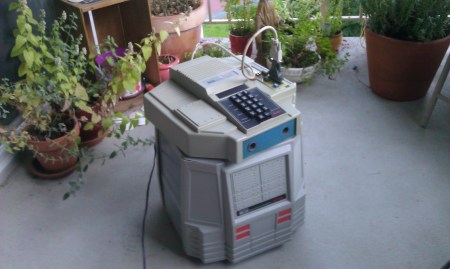For those of you that don’t know, the Heathkit HERO (Heathkit Educational Robot) was a ‘bot built in the early 1980s. [Rick] wasn’t satisfied with his model ETW-18’s programming interface, so decided to upgrade it to be able to run Python using a hacked wireless router. We’d agree that things have advanced since then, since this little guy was originally programmed in machine code using an onboard keypad. As [Rick] points out, it’s “exactly as awful” as it sounds!
To begin restoring and upgrading his robot, a kit was obtained from [hero-1] to allow for a serial programming interface. Although an improvement, the desire was to be able to program this robot using Python, and to not have to have a cable running across the floor all the time. A router with a serial port was obtained from a thrift store, then hacked using [OpenWrt]. After fitting the components into the robot, [FR3DDY] was born, “A ~30 year old robot, accessible through wifi, capable of running Python.”
Be sure to check out his site, which has some videos we weren’t able to embed. He’s also included some Python code that he used to program it. If this has made you curious about the Python language, why not check out this recent post about learning it the hard way?

















Where did you dig up Mr Wizard’s droid??
What, is there something wrong with programming using a hex keypad and looooove?
True story, my dad was part of the team that made the hero 1, and that little fucker was what taught me to walk bakwards. Bumped my head against a table when it came in and started talking to me. And also I had a T-shirt with hero on it that I bulged out of until my sophmore year in high school
I remember one of my fellow vo-tech students who knew no prior programming and the first thing he made this thing verbally speak was Ford sucks lol
about what I would expect from a tech school student.
Now that is a childhood toy i wish i had kept.
In my endless list of unfinished projects is my Hero Jr. that I need to modernize. Kinda forced to. He is missing some of the PCBs. I do have the complete service manual though and several upgrade options.
I do wish I had the Hero 1 instead. Much cooler.
i actually kinda enjoyed putting in hex commands via the pad
I’d like to see a modernized version of Androbots B.O.B.
With current solid state gyro and accelerometer technology the constant wobble back and forth could be eliminated via precision control of the wheel motors.
Stability was provided by using two steeply angled wheels and mounting the batteries really low. The designer wanted an even steeper wheel angle and lower battery position, which would have almost eliminated the wobble but he was overruled by other people more concerned with how wide the robot would have to be.
Another issue with the design is it never had any provision for real arms, just some supports and a few different vacuum formed ABS trays that snapped onto the sides of the body.
Not entirely true, the side panels were steel. You could have easily mounted arms to the side panels. Only the front and rear panels are plastic.
Sorry, I misread and thought you were referring to the hero-1, not the Bob. Disregard earlier comment.
Wed. Feb. 5, 2016 – Hello all… I was one of four people who built and soldered a Heathkit HERO-1 robot with the speech board and arm options. I’m in the process of waking it up from over 30 years of sleep in my basement. I got the computer to say, “Ready.” That’s a start. I’m in the process of replacing the four dead 6V gel cells. Anyone who is willing to share info to revive an old ‘bot friend is appreciated. PS… I can’t find original documentation and manuals. And pdfs of that anywhere? Thanks!
I still have some codes for speech , arm demo and sonar roaming.
Dave,
Would love to trade experiences with the Hero-1.
Just came across your post. Hope it’s still valid.
Ya , I’ve got the codes for roaming a room using the sonar to scan the area .
That sounds great. Until I find a set of manuals, any help programming my working HERO-1 ‘Bot to do something would be appreciated. I’d appreciate STEP by STEP procedures and hex code entry to: Set and show the TIME & Date, Some fun with the sonar system, Show that the LIGHT SENSOR is working. Also… I am the president of a Rotary Club… It would be way cool to program it to say: “Welcome to Rotary. Live the Four Way Test. Service Above Self is what humans and robots can do. Thanks, Rotarians.” My e-mail is DaveBoyer55@gmail.com